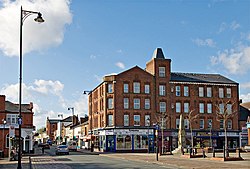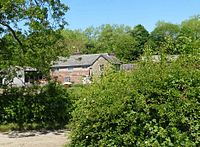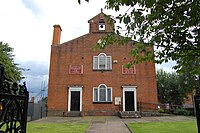Tyldesley
| Tyldesley | |
| Lancashire | |
|---|---|
 Marklands Buildings and Elliott Street | |
| Location | |
| Grid reference: | SD690023 |
| Location: | 53°30’60"N, 2°28’0"W |
| Data | |
| Population: | 14,431 (2011) |
| Post town: | Manchester |
| Postcode: | M29 |
| Dialling code: | 01942 |
| Local Government | |
| Council: | Wigan |
| Parliamentary constituency: |
Leigh |
Tyldesley is a town in Lancashire, found to the north of Chat Moss near the foothills of the West Pennine Moors, nearly eight miles south-east of Wigan and nine miles north-west of Manchester.
Tyldesley and its surroundings have provided evidence for the remains of a Roman road passing through the township on its ancient course between Coccium (Wigan) and Mamucium (Manchester).
In the Anglo-Saxon period Tyldesley was part of the manor of Warrington. After the Norman conquest it constituted a township called Tyldesley-with-Shakerley in the parish of Leigh.[1]
The factory system, and textile manufacture during the Industrial Revolution, triggered a process of population growth and urbanisation such that by the early-20th century it was said that the newly emerged mill town was "eminently characteristic of an industrial district whose natural features have been almost entirely swept away to give place to factories, iron foundries, and collieries".[2] After industrial activity declined in the late-20th century, land reclamation and post-war residential developments have altered the landscape and encouraged economic activity along Elliott Street—Tyldesley's central commercial area and main thoroughfare.
Name
Tyldesley meaning "Tilwald's clearing" is derived from the Old English personal name Tilwald and leah a "wood, clearing", suggesting what is now open land was once covered with forest.[3] The name was recorded as Tildesleiha in 1210. Alternative spellings include Tildeslei, Tildeslege, Tildeslegh and Tildesley.[2]
Tyldesley is at the edge of the Lancashire Plain north of Chat Moss and the Banks is a sandstone ridge where the foothills of the Pennines begin and gave the town its early name of Tildsley Banks. The land rises from 100 fetet above sea level at the foot of the banks to 250 feet at the highest point.
Tyldesley is pronounced "Til-slee", and locally known as "Bongs". In local pronunciation "Banks" was corrupted to "Bongs". The old name for Mosley Common was the "Hurst" or "Tyldesleyhurst".
History
Earliest history
The remains of a Roman road serving camps at Coccium (Wigan) and Mamucium (Manchester) passed through the area. It ran from Keeper Delph in Boothstown crossing Mort Lane north west of Cleworth Hall and south of Shakerley Old Hall.[4] The road continued towards the Valley at Atherton where coins have been found, and on towards Gibfield and Wigan.[5]
In 1947, two urns containing about 550 Roman bronze coins, minted between AD 259 and AD 278, were found near the old Tyldesley–Worsley border.[6] The coins are in the British Museum.[7] After the end of Roman rule in Britain we have little evidence about the Tyldesley area, though the placenames hereabouts, including that of Tylldesley itself, are of Old English origin.[3]
Manor houses
The manor house was Astley Hall which, in 1212, was home to Hugh Tyldesley, Lord of the Manors of Astley and Tyldesley.[8] It is just inside the Tyldesley boundary but has been associated with Astley since the death of Henry Tyldesley in 1301, when the manor was divided among three sons. The Tyldesleys had a "reputation for lawlessness and who had frequent disputes with their neighbours".[8] One exception was Hugh Tyldesley, Hugh the Pious,[9] who endowed Cockersand Abbey with land in Shakerley before his death in 1226. The moated New Hall in the Park of Tyldesley, close to the old manor house was in existence before 1422 when it belonged to Thomas Tyldesley.[10]

The new manor, known as the Garrett, was owned by John Tyldesley in 1505. The timber-framed Garrett Hall remained with the Tyldesleys until 1652 when Lambert Tyldesley died leaving no heir. The new owners, the Stanleys, leased it to tenant farmers. In 1732 it was sold to Thomas Clowes who also leased the property to tenants. In 1829 the estate was bought by the Bridgewater Trustees.[11][12]
The township had several other significant houses. Generations of the Shakerley family lived in Shakerley Old Hall, close to the Shakerley Brook and Roman road. In mediæval times they paid rent to Cockersand Abbey and dues of "one pair of white gloves at the feast of Easter" to Adam Tyldesley.[13]
Chaddock Hall was home to a family of yeomen farmers.[14] Its name was variously recorded as Chaydok, Chaidoke and Chaidok, the last syllable probably meaning "oak".[9] It was surrounded by a hamlet in the east of the township. The Chaddocks, like the Tyldesleys and Shakerleys, had a reputation for lawlessness.[15]
The tenants of the Tyldesley, Shakerley and Chaddock lands were summoned for military service. Archers from Chaddock fought at Crécy in 1346 and at the Battle of Agincourt in 1415.[16] In 1360, William Chaddock was described as an archer on foot, "potens de corpore et bonis" ('fit for active service in body and equipment'). A muster roll described Hugh Tyldesley as an archer on horseback and Hugh Chaddock and Richard Tyldesley were foot-archers drawing daily pay for service from 22 July to 21 October 1391.[17]
Cleworth Hall, recorded as Cluworth in 1333, was part of the Tyldesley lands on higher ground north of the high road.[2] It passed to Nicholas Starkie of Huntroyde by his marriage to Anne Parr in 1578 and in 1594 was associated with witchcraft.[18] Two children, John and Anne Starkie became "possessed of evil spirits". A well-known "conjurer" or wise man, Edmund Hartley, was asked to cure them, which he apparently did before demanding money which was refused. Hartley threatened trouble and Starkie denounced him and Hartley was taken for trial to Lancaster Castle in 1597 where he was tried and found guilty of witchcraft. He was hanged, twice, as the rope broke at the first attempt.[19]
Banks Estate
In the early 18th century Tyldesley was a collection of cottages and farms around the halls scattered across the township with no church or inn. Thomas Johnson, a Bolton merchant bought the Banks Estate in 1728, land from the Stanleys of Garrett Hall in 1742 and Davenports in the west of the township in 1752. He died in 1764 leaving his estate to his grandson with the same name.[20] Thomas "Squire" Johnson developed the town of Tildsley Banks. His name lives on in Squires Lane and Johnson Street. The last quarter of the 18th century marked the beginning of a building boom and the grid plan of the town centre is from this date.[21]
John Aikin described the area in 1795 in his book A Description of the Countryside from 30 to 40 Miles around Manchester:
The Banks of Tildesley, in the Parish of Leigh, are about one mile and a half in length, and command a most beautiful prospect into seven counties: the springs remarkably clear and most excellently adapted to the purposes of bleaching. The land is rich, but mostly in meadow and pastures, for milk, butter, and the noted Leigh cheese. The estate had, in the year 1780, only two farm houses and eight or nine cottages, but now contains 162 houses, a neat chapel, and 976 inhabitants, who employ 325 looms in the cotton Manufactories ...[22]
Tyldesley's first inns were the Flaming Castle built in 1778 and the Green Dragon of 1781.[23] Fulwell House in Squires Lane was built in 1792 and occupied by local industrialists but was demolished in 1935.[24] Towards the end of the 18th century rows of two-storey brick terraced houses were built at the west end of the town to house workers who had migrated there to work in the new factories.
Industrial Revolution
Until the Industrial Revolution, Tyldesley was rural, agriculture and cottage spinning and weaving, mainly muslin and fustian,[25] were the chief occupations before 1800. Silk weaving became an important cottage industry after 1827 when silk was brought from Manchester.[26]
In 1772 Thomas Johnson opened the "Little Factory" for carding and spinning cotton. "The Great Leviathon" powered a steam-driven mill for woollen spinning on Factory Street in 1792. More cotton mills were built close to the Hindsford and Shakerley Brooks which provided water for steam power. In 1823, after a strike for increased wages and lockout by the millowners at New Mills, owned by J & G Jones in Factory Street, the workforce was sacked and new hands hired to replace them. The scab strikebreaking labourers had to be protected from assault by the dismissed workers.[27] Joseph Wilson built Hope Mill in James Street.[28] By 1838 James Burton owned most of the town's mills. He lived in Charles Street surrounded by his workers' houses.[29] His company owned 74 cottages and 57 cellars, a house in Elliot Street and the King's Arms public house. Burton died in 1868. In 1883 a fire at Burton's mills caused £15,000 damage and by 1920 his mills were demolished.[29] Caleb Wright owned Barnfield Mills which had a workforce of about 800. The last of his mills, Barnfield No 6 on Shuttle Street, was built in 1894 on the site of Resolution Mill which was destroyed by fire in 1891. Barnfield No 6 was a concrete-floored multi-storey mill for spinning, powered by an external engine house via a rope race.[30] The mill was demolished in the 1990s and the site is occupied by a supermarket.
Coal had been got in Shakerley since at least 1429 when a dispute was recorded between the Shakerleys and the Tyldesleys over the stealing of "seacoals".[31] Shakerley Colliery on Shakerley Common was in existence in 1798.[32] Shakerley was a centre for making nails,[32] but was in decline by 1800.

After the railway was completed in 1864, coal mining became the dominant industry and the town was surrounded by collieries for more than 100 years until the industry declined after the Second World War.[33] Bridgewater Collieries, Tyldesley Coal Company, Shakerley Collieries and Astley and Tyldesley Collieries were among the local mine owners. Gin Pit Colliery closed in 1955, Cleworth Hall in 1963, Nook two years later, and Mosley Common in 1968. Tyldesley Miners Association, established in 1862,[34] built the Miner's Hall in 1893 and the Astley and Tyldesley Miner's Club opened at Gin Pit in 1927.
The worst mining disaster in the town occurred at Yew Tree Colliery on 11 December 1858 when an explosion of firedamp caused by a safety lamp cost 25 lives, the youngest victim was 11, and the oldest, 35 years of age. Some of the victims are buried in the churchyard at St George's Church.[35][36] Another explosion on 6 March 1877 at Great Boys Colliery cost eight lives[37] and on 2 October 1883, six men died when the cage rope broke at Nelson Colliery in Shakerley.[38] On 1 October 1895 five men including the colliery manager and undermanager died at Shakerley Colliery after an explosion of firedamp.[39]
Grundy's Foundry was another important employer. Its founder, John Grundy invented a warm air heating system that was used in churches and halls. He built a foundry close to the railway in Lower Elliot Street.[40][41]
Industry declined after the Second World War and subsequent land reclamation and new housing developments have changed the face of the town, but its centre retains the atmosphere of a bustling market town,[42] with a refurbished market square. The steep terraces branching off the main streets give the town a distinctive character.
Sights about the town

For many years Tyldesley's landscape was dominated by factory chimneys and pit headgear. Since the closure of the mines and demolition of the factories, St George's Church—one of the few structures in the town built of stone, with a spire rising to 150 feet in height—and Top Chapel in the Market Square have become the chief landmarks; both are Grade II listed buildings.[43][44]
Tyldesley's built environment is almost uniformly constructed of brick.[45]
Among the listed buildings in Tyldesley are Chaddock Hall and Damhouse, both Grade II listed.[46][47][48] Chaddock Hall is a private residence and Damhouse or Astley Hall is a heritage centre having previously been used as the office block for Astley Hospital.[8]
Churches

John Wesley preached in Shakerley four times, between 1748 and 1752, laying the foundations for a place of worship. In the 1780s George Whitfield who worked with Wesley early in his ministry also preached there. Tyldesley's first place of worship, Top Chapel, was built in the Square in 1789 for the Countess of Huntingdon's Connexion which had broken from the Church of England. Thomas Johnson, gave the site on the highest point of Tyldesley and Lady Huntingdon, a supporter of Wesley supplied money for building materials. The chapel became known as Top Chapel from its geographical location.[49]
Before 1825 Tyldesley had no established church, and lay within the parish of Leigh. A chapel of ease, St George's, was built in 1825 on land donated by Thomas Johnson. The church could seat 1,100 people, it is 112 feet in length, 60 feet in width and its spire, a local landmark is 150 feet in height. George Ormerod gave the land for the churchyard and also six bells which were cast at Downham Market.[50]
There were chapels of the Congregational, Primitive Methodist, Wesleyan Methodist, Baptist, Welsh Congregational, Welsh Calvinistic and Independent Methodist connexions.[2] Welsh chapels served the Welsh people who migrated toto the town after the opening of the railway in 1864.
Outside links
| ("Wikimedia Commons" has material about Tyldesley) |
- Tyldesley Rugby Union Football Club, founded 1881
- Tyldesley Historical Society
- Tyldesley Brass Band
- Tyldesley Swimming & Water Polo Club
- Top Chapel
- Tyldesley Family History
- John Grundy and the Foundry
- Tyldesley Past
References
- ↑ Tyldesley with Shakerley Township Boundaries - Genuki
- ↑ 2.0 2.1 2.2 2.3 A History of the County of Lancaster - Volume : {{{2}}} (Victoria County History)
- ↑ 3.0 3.1 Mills 1998, p. 355
- ↑ Newsletter 71, wiganarchsoc.co.uk, http://www.wiganarchsoc.co.uk/content/News_Letters/news071.htm, retrieved 7 September 2009
- ↑ Roman Road, lancashire.gov.uk, http://www.lancashire.gov.uk/environment/historichighways/roman/contourw.gif, retrieved 13 December 2009
- ↑ National Monuments Record: No. 44272 – Coin find
- ↑ Lunn 1953, p. 7
- ↑ 8.0 8.1 8.2 Tonge 2002, p. 5
- ↑ 9.0 9.1 Lunn 1953, p. 5
- ↑ Lunn 1953, pp. 26–327
- ↑ Bond, Ackers & Ward 1979, p. 28
- ↑ National Monuments Record: No. 44270 – Garrett Hall
- ↑ Lunn 1953, p. 6
- ↑ Chaddock Hall, Tony Smith, http://www.tonysmith58.pwp.blueyonder.co.uk/bwsindex.htm, retrieved 2 February 2010
- ↑ Lunn 1953, p. 10
- ↑ Lunn 1953, p. 20
- ↑ Lunn 1953, p. 21
- ↑ Lunn 1953, p. 27
- ↑ Poole 2002, p. 47
- ↑ Lunn 1953, p. 92
- ↑ Historic Maps of Tyldesley, Tyldesley and District Historical Society, http://www.arnw02593.pwp.blueyonder.co.uk/maps_of_tyldesley.htm, retrieved 7 October 2009
- ↑ Aiken 1795, pp. 299–300
- ↑ Lunn 1953, p. 97
- ↑ Lunn 1953, p. 98
- ↑ Lunn 1953, p. 53
- ↑ Holcroft 1998, p. 10
- ↑ Strike, Tyldesley Historical Society, http://www.arnw02593.pwp.blueyonder.co.uk/strike.htm, retrieved 17 October 2009
- ↑ Lunn 1953, p. 107
- ↑ 29.0 29.1 Lunn 1953, p. 114
- ↑ Historic England. "Barnfield Mill (1302494)". PastScape. http://www.pastscape.org.uk/hob.aspx?hob_id=1302494. Retrieved 17 September 2012
- ↑ Lunn 1953, p. 31
- ↑ 32.0 32.1 Lunn 1953, p. 103
- ↑ NW Division map, cmhrc.co.uk, http://www.cmhrc.co.uk/site/maps/lnw_map1.html, retrieved 26 September 2009
- ↑ banner, Tyldesley Miners Association, People's History Museum, http://www.phm.org.uk/keemu/display.php?irn=10388, retrieved 13 August 2009
- ↑ (PDF) Yew Tree Colliery Disaster, cmhrc.co.uk, p. 46, http://www.cmhrc.co.uk/cms/document/1855_59.pdf, retrieved 17 October 2009
- ↑ Alan McEwen Yew Tree Colliery Disaster, handybluepages.co.uk, http://www.handybluepages.co.uk/alan-mcewen-the-yew-tree-pit-disaster-tyldesley-13-december-1858-i418.html, retrieved 17 October 2009
- ↑ (PDF) Great Boys Colliery Disaster, cmhrc.co.uk, p. 9, http://www.cmhrc.co.uk/cms/document/1876_77.pdf, retrieved 17 October 2009
- ↑ (PDF) Nelson Colliery Disaster, cmhrc.co.uk, p. 27, http://www.cmhrc.co.uk/cms/document/1882_83.pdf, retrieved 17 October 2009
- ↑ (PDF) Shakerley Colliery Disaster, cmhrc.co.uk, p. 32, http://www.cmhrc.co.uk/cms/document/1894_95.pdf, retrieved 17 October 2009
- ↑ Victorian_Engineers, hevac-heritage.org, archived from the original on 21 April 2009, https://web.archive.org/web/20090421070825/http://www.hevac-heritage.org/victorian_engineers/grundy/grundy.htm, retrieved 13 August 2009
- ↑ Lunn 1953, p. 131
- ↑ Townships/Tyldesley, Archive.org, archived from the original on 20 May 2013, https://web.archive.org/web/20130520105917/http://www.wigan.gov.uk/Services/CommunityLiving/Townships/Tyldesley/, retrieved 20 May 2015
- ↑ National Heritage List 1163277: Church of St George, Elliott Street
- ↑ National Heritage List 1356244: Tyldesley Chapel
- ↑ (PDF) Tyldesley Town Centre Conservation Area Appraisal, Wigan Council, p. 20, http://www.wigan.gov.uk/Docs/PDF/Resident/Planning-and-Building-Control/Conservation-areas/Tyldesleyfinaldraft1244kb.pdf, retrieved 10 September 2009
- ↑ National Heritage List 1356222: Chaddock Hall
- ↑ National Monuments Record: No. 44271 – Chaddock Hall
- ↑ National Heritage List 1163258: Administration block at Astley Hospital
- ↑ Lunn 1953, p. 100
- ↑ Lunn 1953, p. 110
- Aiken, John (1795), A Description of the Country from Thirty to Forty miles around Manchester, printed for John Stockdale, London
- Ashcroft, Tony (1996), The Sixpenny Rush, PDR Books, ISBN 1-874712-28-X
- Bond, Ackers & Ward (1979), Leigh Homesteads, Leigh Local History Society Publication No. 7
- Grasso, John (2014), Historical Dictionary of Wrestling, Scarecrow Press, ISBN 978-0-8108-7926-3
- Holcroft, Fred (1998), Silk Manufacturing in Leigh, Leigh Local History Society Publication No21
- Horn, Joyce M.; Smith, David M.; Mussett, Patrick (2004), Fasti Ecclesiae Anglicanae 1541–1857: volume 11, British History Online, http://www.british-history.ac.uk/report.aspx?compid=35870, retrieved 9 October 2009
- Lunn, John (1953), A Short History of the Township of Tyldesley, Tyldesley Urban District Council
- Mills, A.D. (1998), Dictionary of English Place-Names, Oxford, ISBN 0-19-280074-4
- Poole, Robert (2002), The Lancashire witches: histories and stories, Manchester University Press, ISBN 978-0-7190-6204-9
- Sweeney, D.J. (1996), A Lancashire Triangle Part One, Triangle Publishing, ISBN 0-9529333-0-6
- Sweeney, D.J. (1997), A Lancashire Triangle Part Two, Triangle Publishing, ISBN 0-9529333-2-2
- Tonge, John & Sylvia (2002), Astley Hall Damhouse, John and Sylvia Tonge, ISBN 0-9515210-2-0
- Youngs, Frederic A, Jr. (1991), Guide to the Local Administrative Units of England, Vol.2: Northern England, Royal Historical Society, ISBN 0-86193-127-0
